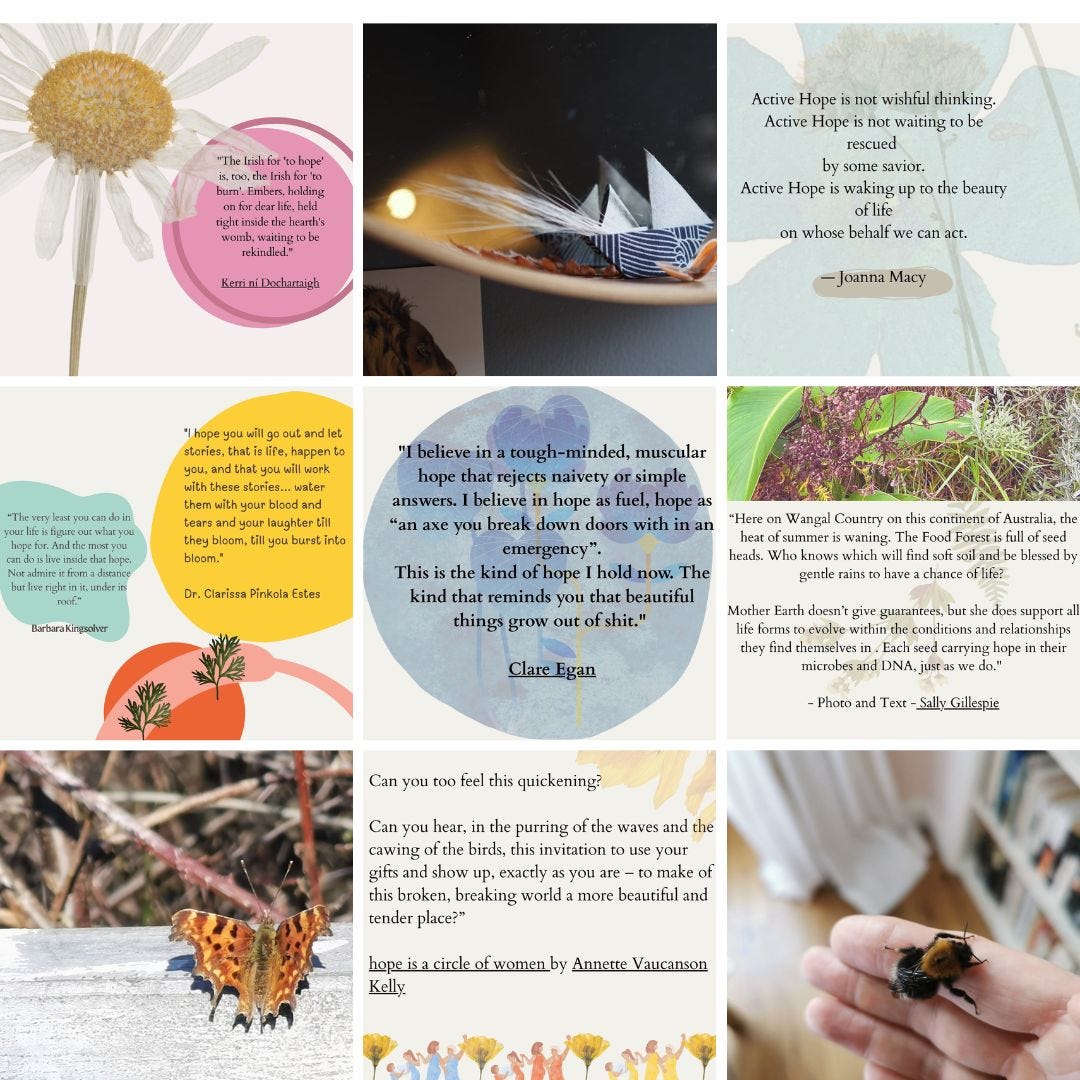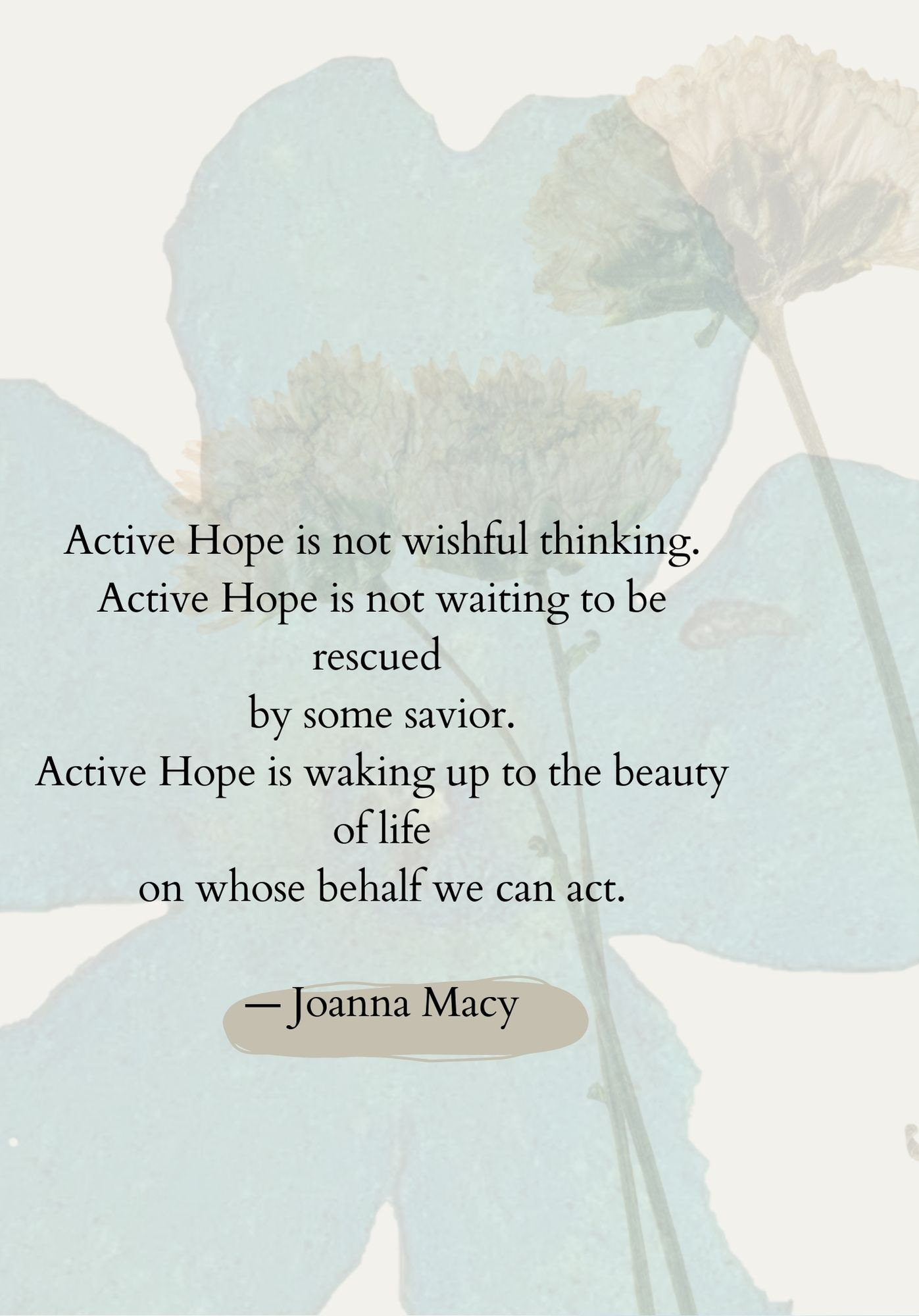Hope - A Scrapbook
The first Notes from Saving the World collaborative scrapbook - offering a new lens on global challenges from trauma survivors, activists, writers and poets.
If someone told me to be hopeful, my immediate reaction would be to roll my eyes.
Hope has for a long time seemed to me, a word used by people who have avoided the hard terrain of life. A space dominated by Instagram quotes and those who don’t want to discuss difficult things.
Yet, recently I started to interrogate my apathy and scepticism - founded on a lot of ‘good’ evidence from working on climate and international aid.
I realised, “Apathy is not a revolutionary stance.”1
That is what got me here, deciding to scrapbook a new version of hope and launching a call for submissions, asking other writers to add their thinking on the topic.
The results of this exploration, are this piece - which is a reflection on my findings - and this more creative scrapbook - which is available as a PDF to subscribers.
This is intended as a creative collection of alternative ideas, reframes and perspectives to bring alive new ways of thinking about our world systems and how we might change them for the better.
Let’s begin in the comfort of hopelessness
I was glad the first piece I read about hope started in hopelessness.
Clare Egan begins within the rough ground of trauma recovery. And because she starts with hopelessness, the hope she talks about seems achievable.
I love that she writes: “Sometimes, hopelessness is rational.”2 Because, for so many of us, this is the state we meet the world. Life has shown us, not only our hope for something better, but our big dreams and our careful wishes, are not going to be fulfilled.
When we are in these places of despair, hope seems ridiculous, because now we have evidence that our careful work and courageous efforts do not stand a chance.
As someone who has spent years recovering from traumas in my own life, Clare’s version of hope feels real to me.
“I’m suspicious of those who traffic in unearned hope, who insult suffering people by saying that they ought to be more optimistic. Blind, naive hope is never useful. Often, it’s dismissive of deep pain. … Ignorance dressed up as hope is as destructive as denial."3
It is an agile hope that Clare lands upon and one which seems possible for all of us to grow:
"I believe in a tough-minded, muscular hope that rejects naivety or simple answers. I believe in hope as fuel, hope as “an axe you break down doors with in an emergency. This is the kind of hope I hold now. The kind that reminds you that beautiful things grow out of shit."4
What if those who have hope are the ones who seem they should have lost it?
As I did more reading, I realised I had been exposed to a narrative about hope which made me see it as flimsy. Something light, virtuous and pious. When really, hope is tough. And those who cultivate hope tend to be the ones who seem they should have lost it.
I was reminded of words I wrote in Myanmar in 2013:
“I learn hope
like a new word.
Heavy with mud. Hard like a stone.”5
In those first years I lived in Myanmar (from 2012) it felt like a country brimming with both tentative and resolute hope. The foundations of democracy being laid in place after 50 years of dictatorship. I remember the goosebumps on my arms in the almost completely silent Yangon, the day of the first elections in 2015.
Yet, in 2025, the politics in Myanmar have shifted again, which is perhaps one of the reasons I see hope as such a tricky concept to trust. So many things in my life - from country politics to relationships, to jobs - which seemed filled with hope, have shifted under my feet, exposing my hope as naive, misplaced or unreliable.
Mariame Kaba describes hope as a discipline (which reminds me of having committed Ashtanga yoga routine). I like that she goes on to say: “you have to prepare for the day after the revolution. And even when you do that, it’s not guaranteed that things are going to go as you had hoped.”
This shone a new light on some of my perceptions of Myanmar’s shifts and changes.
Hope exists because a wish has not yet come to fruition. Hope requires dark times to come alive. It grows in the quiet in-between - when it seems like nothing is changing and our dreams impossible.
But it also requires consistency to become more than hope. Kaba offers a very pragmatic action plan to how to approach change. No false promises or marketing goals here:
“And that just is what I think we do. We don’t know. But we’ll try. We’ll make lots of experiments. We’ll work with lots of different kinds of people. We’ll build movements, not clubs. This is what we’re going to try, and we’ll do our best.”6
Hope has no guarantees
Sally Gillespie also touches on this theme, noting that what we plant may not come to fruition:
“Here on Wangal Country on this continent of Australia, the heat of summer is waning. The Food Forest is full of seed heads. Who knows which will find soft soil and be blessed by gentle rains to have a chance of life?Mother Earth doesn’t give guarantees, but she does support all life forms to evolve within the conditions and relationships they find themselves in."7
Sally’s perception of hope is also counter the systems we are governed by. She asks us to consider Are our dreams our own? Or are they stories sold by a system which, if dismantled, might allow room for better?
“It is hope’s wise voice that urges us to recognise all the ways that modern lifestyles, with their primary pursuits of control, comfort and consumerism, have become maladaptive for life on Earth, and for human wellbeing.” 8
The same way planted seeds come with no guarantees, neither do our dreams, even if manifestation gurus or those old narratives about ‘how life works’, promise otherwise.
Hope can drive systems change
In what became an unintended research deep-dive, I realised that people who grapple with hope are not faint-hearted.
I delved into the work of writers who have inspired me. I always go back to Rebecca Solnit’s piece in the Guardian. She helped me see different ways to think about the climate crisis, considering the shifts which have occurred through social movements over the past 50 years. And she reminds us: “A lot of assumptions were yet to be dismantled; a lot of alternatives yet to be born.”
Things are not as fixed or established as they might seem.
Leah Lakshmi Piepzna-Samarasinha also envisions these sorts of transformations. She does not share a rigid dream for an unforeseen future, rather she perceives an agile movement, which, as it gains momentum, shapes new systems:
“For years awaiting this apocalypse, I have worried that as sick and disabled people, we will be the ones abandoned when our cities flood. But I am dreaming the biggest disabled dream of my life—dreaming not just of a revolutionary movement in which we are not abandoned but of a movement in which we lead the way. With all of our crazy, adaptive-deviced, loving kinship and commitment to each other, we will leave no one behind as we roll, limp, stim, sign, and move in a million ways towards cocreating the decolonial living future. I am dreaming like my life depends on it. Because it does.”9
Annette also urges a similar momentum:
“I put words down on a page, one after the other – this is what I do. Words to make you think, words as medicine for our times, words to inspire, which means to “give breath”.
Inspire people, inspire change, inspire hope – hope as the tending of a wind-blown flame (Brigid’s flame, surely) and momentum.
I write to make the revolution irresistible.”10
Hope goes full-circle
What almost all the writing of hope I read alluded to, is a word which represents something interwoven, something communal and something in flux. Powerful in its agility, in particular its potential to gain enough momentum to change existing systems and realities.
Annette Vaucanson Kelly and Juliet Fay bring alive the feeling of hope in community, in particular in circles of women both online and offline, where connecting, allows room for new growth.
Their circles are forward-looking, asking what is next?
“In long distance chats
we explore
new ways of being,
delighting in
each other.
Lighting up at the
thought of each other.
.
Now strong roots and shoots
entwine among and
between generations,
a network of women,
alone and together,
daughters, sisters,
nieces
mothers, widows,
wives, partners
grandmothers, aunties,
grand-daughters,
sisters-in-law,
step sisters,
soul sisters,
sisters all.
Bound at birth
or found along the way,
holding up a lantern
showing the path
towards a different future.”11
“Can you hear, in the purring of the waves and the cawing of the birds, this invitation to use your gifts and show up, exactly as you are – to make of this broken, breaking world a more beautiful and tender place?”12
Annette’s invitation into shaping hope seems a good place to close this circle, for now.
We are obviously only skimming the surface of what could be a lifetime’s work (or at least a very thorough PhD thesis).
But maybe that is the invitation we can take with us?
Identifying hope in our lives, like these writers.
To learn which conditions allow hope to thrive. So it can gain the momentum to transform into what we are hoping.
Friends,
Please do join the conversation in the comments. I am sure you have lots to add to this already rich collection of ideas.
There will be more scrapbooking topics in the months to come. So, do subscribe if you would like to submit your words.
The topic which won the poll for the next scrapbook was, ‘Shifting the Western Lens’ which sounds like a daunting adventure to articulate and explore together. Looking forward to that!
If you enjoyed this piece, you can like this piece, share it with a friend and - if you want to fuel the next newsletter - my creative inspiration comes in the form of flat whites.
Hopefully, until next time,
Catriona
If you enjoyed this compilation, you will also enjoy the full articles by the authors featured here:
Hope exists no matter who wins, Clare Egan
Hope exists no matter who wins, Clare Egan
Nature’s Scheme, Catriona Knapman (published in print).
Interview between The Intercept and Mariame Kaba
Hope? The question I am most often asked Sally Gillespie
Care Work: Dreaming Disability Justice, Leah Lakshmi Piepzna-Samarasinha
Hope is a circle of women, Annette Vaucanson Kelly







This is such a great collaborative research project into something we so badly need to re-configure. I loved being prompted to write and therefore think my way into where I sit with hope now. Thank you Catriona for the openness, depth and beauty you have brought to this, and for creating community in the process.
This is such a complex and beautiful subject, expressed in so many amazing ways here. Lovely to see this project come to life. ‘Agile hope’ resonates so much. 🩶